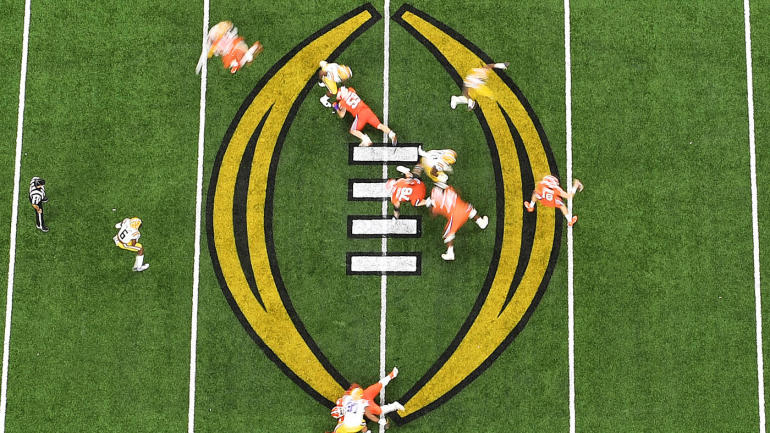
Despite the rash of conference realignment this offseason, it is expected that agreed-upon 12-team College Football Playoff format will maintain its structure at least for the 2024 season, sources told CBS Sports.
The main reason: It would take an unanimous vote of the CFP Management Committee -- 10 commissioners and Notre Dame's athletic director -- to make any change to the 12-team format at this point, sources confirmed.
The 12-team structure in place for 2024 will include see the six highest-ranked conference champions populate the field as automatic qualifiers with six other at-large teams receiving playoff bids.
With the sport in a state of flux and it up in the air how many FBS conferences will even exist once next season rolls around, it would be almost impossible to find consensus on the subject of which conferences deserve AQ status.
The original idea behind guaranteeing spots to the six highest-ranked conference champions was that, most years, not only would the Power Five league champions have access to the playoff but so would at least one champion from a Group of Five conference.
Maintaining the 6+6 structure for 2024 would put off speculation that the number of automatic qualifiers will decrease with the expected loss of the Pac-12. The two other structures that have been informally suggested are 5+7 with five AQs (accounting for the expiration of the Pac-12) and the 12 highest-rated teams -- regardless of conference championship status -- earning CFP bids.
The committee will gather for a regularly scheduled two-day meeting beginning Tuesday in Chicago. Even if alternate models are proposed at the meeting, it will only take one dissenting vote to keep the agreed-upon structure in place.
American commissioner Mike Aresco told CBS Sports this week that he was against any immediate structure change that reduces the automatic berths.
Following a Tuesday report that made it seem as if Aresco changed his mind and found a 5+7 model acceptable, the commissioner clarified his position.
"I said to [the media in Chicago] I still favored 6+6 during the next two years," Aresco told CBS Sports. "But I knew we were headed to 5+7. It was inevitable. In the next two years, we want 6+6. Why would we give that up?"
Why would Aresco be amenable to a 5+7 model in two years? After the 2025 season, much of the structure and format of the 12-team playoff will be up for consideration, including the 6+6 model. When the new media rights deal kicks in starting in 2025, the structure and format of the CFP could change. Aresco understands that and is willing to offer some flexibility.
SEC commissioner Greg Sankey has said on numerous occasions that he would favor a structure that featured 12 at-large teams.
"I think the best [12] teams in the playoff are most healthy," Sankey told reporters earlier this month. "That's not where a lot of my colleagues are."
The CFP Board of Managers -- comprised of 11 university presidents and chancellors -- is the final authority that oversees the playoff.
"It's not up to me," Sankey added. "My view is there was a format decided. If you look deeply at the transition of teams and what that means, you would have a set of years where unranked teams would have been conference champions eligible for the playoff. That just doesn't work."
For example, only once since 2011 has the Conference USA champion been ranked in the final AP Top 25 before bowl games commenced. (No. 23 UTSA last season.) In the current four-team playoff, the highest-ranked Group of Five champion is awarded a New Year's Six bowl bid. If that champion is not in the CFP Rankings as released publicly, that determination is made by the CFP Selection Committee.
The CFP Management Committee last met in late August before Stanford, California and SMU joined the ACC beginning in 2024. Washington State and Oregon State remain in limbo for next season.
"When the CFP Management Committee [last] met, the Pac-12 -- after announced departures -- still had four remaining members," Sankey said. "Later that week, Stanford and Cal moved. We have not gathered again. Respectfully, the Pac-12 still exists. There has to be clarity on its future and direction."
NCAA bylaws state that a conference must be comprised of at least eight members. However, there is a two-year grace period for a league to achieve that number. It is largely assumed Washington State and Oregon State will eventually land in the Mountain West. Sankey was asked whether they could play as a two-team conference for those two years.
"The CFP -- just so we're all clear -- is not the NCAA," he said.
Pac-12 commissioner George Kliavkoff will be at this week's meeting. It's not clear whether he still maintains CFP voting rights on current issues.
While not much is expected to be decided at this week's meeting, urgency looms. The commissioners and CEOs are expected to elect a new executive director -- replacing the retiring Bill Hancock -- by Christmas.
Negotiations will begin soon on a new CFP media rights agreement that begins in 2026. The new contract could be the largest in college sports history. One of the most important parts of that deal will be how revenue is distributed amongst the conferences.
Currently, Power Five leagues receive approximately 80% of the annual revenue distribution. It remains unclear if an unanimous vote will be required to change that formula with the emergence of a Power Four following the Pac-12's dissolving.





















